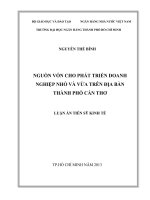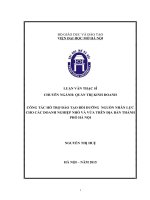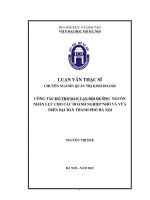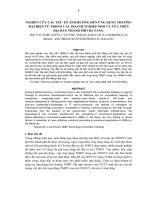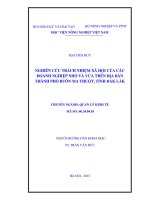Nghiên cứu các yếu tố ảnh hưởng đến chất lượng hệ thống thông tin kế toán tại các doanh nghiệp nhỏ và vừa trên địa bàn thành phố hà nội tt tiếng anh
Bạn đang xem bản rút gọn của tài liệu. Xem và tải ngay bản đầy đủ của tài liệu tại đây (138.41 KB, 24 trang )
1
INTRODUCTION
1. The necessary of this research
Accounting information system (AIS) is a sub-system of
management information system that has key functions include
recording, processing transactions and providing financial
information of enterprise for stakeholders. Research on evaluating
the quality of accounting information systems and determinants
influencing the quality of accounting information system are
essential issues in both theoretical and practical aspects.
On the theoretical perspective:
Firstly, it is information quality. The strong application of
information technology in accounting has required the quality of
accounting information. Previous studies showed that accounting
information has not been properly assessed and is not a reliable
source of information for making economic decisions. Therefore,
establishing evaluation criteria and identifying factors affecting
the quality of accounting information systems based on the
approaches of economic theory will bring theoretical significance
Secondly, it is information processing. The context of the
strong application of information technology in the Industrial
Revolution 4th has affected the accounting information systems of
enterprises in general and small and medium-sized enterprises in
particular. However, the application of technology and
information applications in small and medium-sized businesses
focuses more on bookkeeping such as ledger, liabilities, or
inventory control but has not equipped much for financial
analysis, budgeting, or project management.
Thirdly, it is the changes in the global business context as
well as the management requirement that need more studies to
assess the quality of accounting information systems as well as
2
investigate factors influencing the quality of information systems.
Based on the research results, the policy implication is suggested
to improve the quality of accounting information systems in
enterprises. The current trend in the world is to use a variety of
criteria to evaluate the quality of accounting information systems.
However, studies in Vietnam often stop at using single criteria to
measure or propose combinations of multiple criteria but lack of
empirical data to verify the scales. Therefore, researching the
quality of accounting information systems and factors affecting
the quality of accounting information systems will bring new
contributions to the theoretical framework.
From the practical perspective: Small and medium
enterprises account for over 98% of the total number of
businesses in Vietnam. However, the facts show that small and
medium-sized enterprises are still facing difficulties in the
production and business activities such as low productivity issues,
outdated technology, and shortages. Regarding financial and
human resources, and especially building a strong accounting
information system that can provide useful financial information
for business decision making.
Investigating factors affecting the quality of accounting
information systems helps corporate governance, esspecially in
the SME context.
Thus, theoretical and practical requirements show that there
should be more research and development of criteria to
comprehensively assess the quality of accounting information
systems as well as identify factors affecting the quality of
accounting information systems to propose appropriate solutions
for the sustainable development of SMEs.
2. The research objectives
3
The objectives are to determine the criteria for evaluating
the quality of accounting information systems and investigate the
factors affecting the quality of accounting information systems.
Then, the study proposed recommendations to improve the quality
of accounting information systems in SMEs.
3. Research statement and scope
3.1. Research statement
This research focuses on theoretical issues and the reality of
the quality of accounting information systems and the factors
affecting the quality of accounting information systems in small
and medium enterprises.
3.2. Scope
- Content: The study approaches the content of accounting
information system quality and the factors affecting the quality of
accounting information systems.
- Space: Data was collected in Hanoi.
- Time: Data collected in 2018.
4. Research question
(1) Which criteria are suitable for evaluating the quality of
accounting information systems for SMEs? What is the reality of
the quality of AIS in SMEs in Hanoi?
(2) What are the influencing factors and their influence on
the quality of AIS in SMEs in Hanoi?
(3) What are the recommendations to help improve the
quality of AIS for SMEs in Hanoi?
5. New contributions of this research
Theoretical contributions:
The results of the research contribute to the theoretical
framework of the quality of accounting information systems in
SMEs that including system quality and information quality. The
4
results show that contingency theory is suitable in assessing the
impact of factors on the quality of accounting information
systems.
Practical contributions:
The research provides a picture of the quality of accounting
informatin systems in SMEs in Hanoi. By testig hypotheses, the
research states the effect of five factors on the quality of
accounting information systems. The factor information
technology hass a strong impact on system quality, whislt the
participant of manager in implementing AIS has a strong impact
on information quality. This paper provides solutions to improve
accounting information system quality and improve corporate
governance efficiency.
6. The structure of the research
Exclude introduction, the structure of the research includes
5 chapters.
Chapter 1. Literature review
Chapter 2. Theoretical framework of the quality of
accounting information systems and factors affecting the quality
of accounting information systems
Chapter 3. Methodology
Chapter 4. Results and discussion
Chapter 5. Recommendations to improve the quality of
accounting information systems in small and medium-sized
enterprises in Hanoi
5
CHAPTER 1: LITERATURE REVIEW
1.1. The quality of accounting information system
The criteria of the quality of AIS:
The results of the previous studies show that organizational
impact is a commonly used criterion to evaluate the quality of
AIS. It can be seen that the authors' approach to measuring the
quality of technical information systems is based on the benefits
of the accounting information system, through assessing the
impact of the accounting information system on the operation
process of enterprises (Sajady et al., 2008). However, the
limitation of this measurement is not a comprehensive
consideration of issues of the quality of accounting information
systems such as system quality, information quality. To overcome
the limitations in the evaluation of the quality of accounting
information systems, studies in recent years have tended to use a
combination scale to evaluate the quality of accounting
information systems. Many studies use a combination of multiple
criteria when measuring the quality of accounting information
systems.
The study of Nicolaou (2000) or the study of Fardinal
(2013) or the study of Susanto (2017) have employed a
combination scale that reflect technical aspect and user
satisfaction. The study of Chalu (2012) was proposed a multidimensions mearsure of the quality of accounting information
systems. In Viet Nam, the study of Huỳnh and Nguyễn (2013)
was proposed a combination in evaluating the quality of
accounting information systems.
Characteristics of the context of the previous studies:
The quality of accounting information systems was
researched in the both of the developed countries like American in
6
the study of Nicolaou (2000), and the developing countries like
Iran (Sajady và ctg., 2008), Jordan (Alzoubi, 2011), Indonesia
(Fardinal, 2013; Susanto, 2017), Tanzania (Chalu, 2012).
Research on the quality of accounting information systems
is also conducted in enterprises of different sizes and different
business sectors. The characteristic of firm size also leads to the
choice of measurement criteria for the quality of the AIS. For
example, listed enterprises or large enterprises operating in
industrial zones have their financial department and separate IT
department. Therefore, the study of the quality of technical
information systems in large enterprises, in addition to the
director and the accounting department, needs to examine the
assessments of the financial director or the IT department
(Alzoubi, 2011; Nicolaou, 2000; Sajady et al., 2008). Meanwhile,
small and medium-sized enterprises, with limited resources, may
not have their finance or IT departments. Therefore, studies in the
context of small and medium-sized enterprises often focus on
stakeholders such as business directors, chief accountants, and
accountants.
1.2. Literature view of factors affecting the quality of
accounting information systems
Researchers have many approaches to learn about factors
affecting the quality of accounting information systems. Studies
can approach different background theories, using different
methods, in different research contexts to select the appropriate
factors and assess their impact on the quality of accounting
information systems. In the study of factors affecting aspects of
accounting information systems such as the design,
implementation or quality of accounting information systems,
contingency theory is commonly used. Contingency theory
approaches factors affecting in the context of enterprises, taking
7
into account both internal and external factors. Besides, many
studies have investigated a theoretical framework of influencing
factors from the results of previous studies to build a research
model of the factors affecting system quality. Accounting
information such as the research of Nguyen Thi Bich Lien (2012),
Sačer and Oluić (2013), Rapina (2014), and Meiryani and Susanto
(2018).
In summary, the researches over the world had different
theoretical approaches, so each study has proposed a research
model of the factors affecting the quality of accounting
information systems. However, from the literature review, it is
shown that contingency theory is an appropriate approach in
studying factors affecting the quality of accounting information
systems.
1.3. Research gap
- The lack of empirical studies on the quality of
accounting information systems in SMEs in Vietnam
The literature review shows that there is a lack of evidence
on the quality of accounting information systems in SMEs in
Vietnam. While Vietnam is a developing country with more than
98% are SMEs. The lack of research in Vietnam has created a gap
that needs to be done to reinforce the theoretical framework for
evaluating the quality of accounting information system in the
context of SMEs of developing countries.
- The gap in the measurement of the quality of
accounting information systems
The research on the quality of accounting information
systems in SMEs in Vietnam employed single scales such as the
quality of output information, very few studies have conducted
the assessment of the quality of accounting information systems,
8
using multidimensional measurement or combining many
evaluation criteria.
- Heterogeneity in previous results
Heterogeneity of research results for factors affecting the
quality of accounting information systems. There is a lack of
research on the influence of factors on the quality of accounting
information systems in SMEs in Hanoi.
- The research method
The results show that few studies use complex tests to
assess the measurement of the quality of accounting information
systems and the determinants in the Vietnam context.
Conclusion of chapter 1
Chapter 1 focuses on the literature view related to the
quality of accounting information systems and factors affecting
the quality of accounting information systems. This chapter also
illustrates the research gap
9
CHAPTER 2: THEORETICAL FRAMEWORK OF THE
QUALITY OF ACCOUNTING INFORMATION SYSTEM
AND FACTORS AFFECTING QUALITY OF
ACCOUNTING INFORMATION SYSTEMS
2.1. Theoretical framework
2.1.1. System theory
System theory suggests that the accounting information
system is a subsystem in the enterprise management information
system. Therefore, when considering the system change, it is
necessary to place the accounting information system in the
context of the business, taking into consideration the implications
for other departments. In addition, when proposing solutions,
there should be integration and consensus among the subsystems
towards the goal of the enterprise. System theory also provides
the basis for the selection of factors affecting the quality of
accounting information systems, including internal and external
factors.
2.1.2. Communication theory and information system success
model
The communication theory and IS success model is a suitable
theory to identify the criteria and variables to measure the quality
of accounting information systems. Therefore, this study will
approach the measurement and employ the measurement for
evaluating the quality of accounting information systems - this
approach has been evaluated in recent years because the criteria in
this measure will fully assess the aspects of the system. However,
this study will also select appropriate criteria for the accounting
information system in SMEs context based on inheriting the
results of previous studies. The content of determining the criteria
10
for measuring the quality of accounting information systems will
be presented in section 2.2.2.2.
2.1.3. Contingency theory
Many studies use contingency theory in management
information systems and accounting information systems such as
Gordon và Miller (1976); Gordon & Miller (1976), Weill và
Olson (1989), Nicolaou (2000) hay Ghorbel (2017). This shows
that contingency theory is suitable to identify factors affecting the
quality of AIS. Based on contingency theory, this study identifies
factors that belong to the nature of enterprises and the business
environment. The content of the determinant of factors is going to
show in section 2.3.
2.2. Accounting information system and the quality of
accounting information systems
2.2.1. Accounting information system
2.2.1.1. Definition
In this study, accounting information system is a subsystem
of management information system, with a combination of
components in the system to implement its function such as
acquiring, processing, analyzing, and providing financial and nonfinancial information for stakeholders as well as controlling
activities in the enterprise.
2.2.1.2. The role of the accounting information system
- A tool to help businesses evaluate the performance of businesses
- An effective information tool
- A tool to help manage business activities
- Providing conditions to help businesses develop sustainably
2.2.1.3. Elements of accounting information system
11
In this study, the main components of the accounting
information system are divided similarly to the study of
Allahverdi (2011). The accounting information system consists of
5 main components: (1) User, (2) Data resources, (3) Data
collection, (4) Data processing, (5) Database management.
2.2.2. The quality of accounting information system
2.2.2.1. Definition
Quality of accounting information system is integrated
between components in the system to perform the functions of
collecting, processing, storing and provide accounting
information that meets the standards in the information processing
process as well as accounting information standards and brings
satisfaction to the users.
2.2.2.2. The criteria for evaluating the quality of accounting
information systems
The measurement of the quality of accounting information
system can be used individually or in a combination of multiple
criteria. Petter, Delone, and McLean (2008) have asserted that the
selection of criteria for evaluating the quality of an information
system depends on the business context such as characteristics of
the nature of the business and the purpose of the system. In the
context of the accounting information system, system quality and
information quality are employed because these are the two best
measures for all types of information systems (Delone & McLean,
2002).
2.3. Factors affecting the quality of accounting information
system
This study is based on contingency theory to find out the
factors that affect the quality of accounting information system.
The factors affecting the quality of accounting information
12
systems in this research model include environment,
organizational
structure,
information
technology,
the
participation of managers in accounting information system
implementation, accountant resource.
2.3.1. Environment
Because of the importance of business environment, this
study inherits previous results. The environment is measured by
competitiveness in the business environment. Businesses,
especially SMEs, when operating in a highly competitive business
environment, will need the information technology system to
handle transactions quickly, as well as information quality helps
firms react promptly to the environment. Therefore, the study
proposes 2 hypotheses H1 and H2.
2.3.2. Information technology
Information technology plays an important role in promoting
the design, implementation, and quality of accounting information
systems in enterprises. Previous research results have shown that
businesses that apply good information technology will help the
transactions processing be faster, as well as accounting
information will be good in content and format. So, hypotheses H 3
and H4 are proposed.
2.3.3. Organizational structure
This study measures organizational structure by the degree of
decentralization within the firm. Study to develop the hypothesis
H5 on the positive relationship of the degree of decentralization in
the enterprise to system quality. The proposed hypothesis H 6
agrees with Ghorbel (2017) on the positive effect of the degree of
decentralization in an organization on information quality.
2.3.4. Participation of managers in accounting information
system implementation
13
Based on the impact of the management's involvement in the
accounting information system implementation, it is possible to
confirm the role of managers and their impact on the quality of
the accounting information system. Hypotheses H 7 and H8 are
proposed with a positive relationship between the involvement of
managers in implementing accounting information systems and
the quality of the accounting information system.
2.3.5. Accountant resource
The study has affirmed the role of the accounting team
measured by the capacity and engagement of the accounting team
in improving the quality of technical information systems,
specifically in improving the professional handling process as
well as improving high- quality information. Therefore, the study
proposes a hypothesis for H9 and H10.
Conclusion of chapter 2
The content of chapter 2 provides the theoretical framework
of the quality of accounting information systems as well as the
factors affecting the quality of accounting information system.
14
CHAPTER 3: METHODOLOGY
3.1. Research model and hypotheses
Based on the contingent factors in the study of Weill and
Olson (1989), the results of previous empirical studies, and the
interview results, the factors that affect the quality of accounting
information systems are selected and employed in the proposed
research model as Figure 3.1.
F
igure 3.1. Research model
3.2. Construct measurement
• Quality of accounting information system
The quality of accounting information systems is measured by
two criteria system quality and information quality. System
quality and information quality are employed from the research of
Gorla et al. (2010). System quality and information quality are
measured by the 7-points Likert scale in the ascending point from
(1) Strongly disagree to (7) Strongly agree.
- Environment: This study measures environment by the
competitiveness of the business environment according to Thong
(1999). The competitiveness of the business environment is
15
measured by the 7-points Likert scale from 1 to 7, with (1)
Strongly disagree to (7) Strongly agree.
- Organizational structure: This study adopts the measure of
Sabherwal et al. (2006) and uses Likert 7-points scale, with (1)
No decentralization and (7) Complete decentralization.
- Information technology: This study applies the measure of
Sakaguchi and Dibrell (1998). The Likert scale that Louadi
(1998) and Worrall, Remenyi, and Money (1998) proposed to
measure perceptions of computerization in management is
employed, with (1) No computer use, (2) Low computerization,
(3) Medium computerization, (4) High computerization, (5) Very
high computerization.
- Manager participation in the accounting information
system implementation: The study applied Ismail and King's
scale (2007) with Likert 7 scale increasing from 1 to 7, with (1)
Strongly disagree, and (7) Strongly agree.
- Accountant resource: The accountant is adopted from
Gooderham et al. (2004). The research uses a 5-points Likert
scale in ascending order from 1 to 5, with (1) Strongly disagree,
and (5) Strongly agree.
3.3. Sampling
The sample size was performed according to Nguyễn Đình
Thọ (2013) cited Hair, Black, Babin, Anderson, và Tatham (2006)
that the sample size for exploratory factor analysis (EFA). With
21 measurable observed, the minimum sample size for EFA
analysis was 105, so the study's expectation of 200 respondents.
Object of survey
Inheriting the viewpoints of previous studies, this study
carried out a survey of subjects within the enterprise, including
managers at all levels of the enterprise: Board of Directors
16
(general director, executive director executive, deputy director),
chief financial officer, head of departments (in charge of sections
such as purchasing, sales, manufacturing, IT), chief accountant or
accountant; Accountant, general accountant.
3.4. Research method and research design
3.4.1. Research method
Data collection: Research using qualitative methods such as
interviews, expert discussions. Besides, data is collected directly
and online through surveys.
Data analysis: The study used statistical techniques with the
support of SPSS 20 and Amos software.
3.4.2. Research design:
Conclusion of chapter 3
Chapter 3 presented the research methods applied in the
topic including modeling and research hypotheses, measurement
of research variables, methods of data collection and analysis, and
research design.
17
CHAPTER 4: RESULTS AND DISCUSSION
4.1. Characteristics of small and medium-sized enterprises in
Hanoi
Characteristics of the business sector
Characteristics of capital ownership
Characteristics of the age of firm
The competitiveness in the business environment of
SMEs
Characteristics of organizational management in SMEs
- Characteristics of manager participation in accounting
information system implementation.
- Accountant resource in SMEs
- The level of information technology equipment in SMEs in
Hanoi
4.2. The results of testing the research model
4.2.1. Reliability test
With the results of running the reliability test of Cronbach's
Alpha coefficient from SPSS 20 software, the measurement factors
of dependent and independent variables of the research model have
Cronbach's Alpha coefficient ≥ 0.6, and the system correlation
number - total ≥ 0.3. Thus, the measurement scales of the research
variables ensure reliability.
4.2.2. Exploratory factor analysis (EFA)
The results of EFA, after being excluded from the SQ9
indicator are presented in Appendix 5. The results show that the
KMO coefficient = 0.989> 0.5. Bartlett’s test result is 15455,539
with a Sig significance level. = 0.000 <0.05, reject the hypothesis
Ho: Observed variables have no correlation with each other on the
whole. Thus, the hypothesis that the factor model is inappropriate
18
will be rejected. This proves that the data used for research is
perfectly appropriate. The total variance extracted is 71.887%>
50% that is satisfactory. The value of the factor Eigenvalues is
1,213> 1, stop at step 7. The rotation results reveal 7 factors.
4.2.3. Confirmatory factor analysis
The goodness of fit is good, including Cmin/df = 3,189 < 5,
AGFI = 0.855> 0.8, CFI = 0.944> 0.9, TLI = 0.932 > 0.9, only
GFI criterion = 0.891 <0.9. Research results have shown that the
proposed research model is very suitable. The analysis results
show that the theoretical model is measured by 2 variables of
system quality and information quality and 5 independent
variables. The results are completely suitable to perform the steps
to test the influence of factors on the quality of the AIS.
4.2.4. Structure equation model
The results show that SEM is suitable. The results with Rsquare of information quality = 0.48 and system quality with Rsquare = 0.54. The results of SEM with P-value result <0.05, with
5% significance level, hypotheses H1, H2, H3, H4, H6, H7, H8,
H10 are accepted while rejecting hypothesis H5 and H9.
The standardized regression factors affecting system quality
(SYSQ) are respectively: information technology (IT-INV: 0.466),
manager participation in AIS implementation (PART: 0.387) and
environment (ENVIR: 0.133). The standardized regression
coefficients of information quality are, in turn, manager
participation in AIS implementation (PART: 0.453), information
technology (IT-INV: 0.25), business environment (ENVIR:
0.207), organizational structure (STRU: 0.191) and accountant
resource (ACCO: 0.116).
4.3. Discussing the quality of accounting information systems
in SMEs in Hanoi
19
4.3.1. Results of the quality of accounting information systems
4.3.1.1. System quality
• Comparing system quality by firm size
The results show that system quality in medium-sized
enterprises has better than small-scale enterprises. Small
businesses often have limited resources. Therefore, IT equipment
is more limited than medium-sized enterprises, leading to poor
system quality compared to medium-sized enterprises.
• Comparing system quality by business sector
The results indicate that the system quality of agriculture
enterprises are mostly better evaluated, except well-integrated
item. Next is the system quality of industrial - construction
enterprises and finally the system quality of commercial - service
enterprises.
4.3.1.2. Information quality
Information quality indicators in SMEs in Hanoi include:
Accounting information on the screen and printed information are
accurate, complete, concise, useful for daily tasks, comparable.
• Comparing information quality by firm size
•
Comparing information quality by business sector
4.3.2. Discussion of the quality of accounting information
system in SMEs in Hanoi
System quality is higher than the average and information
quality generated from accounting information systems in SMEs
is good. Therefore, businesses need to take measures to improve
the quality of AIS. Analyzing according to the firm size and
business sector, system quality and information quality are also
uneven among types.
20
4.4. Discuss the results of the factors affecting the quality of
accounting information system of SMEs in Hanoi
The results of SEM show that the level of explanation of the
model is good (R-square of system quality and information
quality are 0.54 and 0.48 respectively) and are consistent with the
results of the previous study. For example, the study of
Mokodompit and Wuriasih (2017) with R-square of 0.503 or the
study of Ismail (2009) have R-square of 0.411, or the study of
Fitriati and Susanto (2017) has an R-square greater than 0.5. From
these results, it can be confirmed that contingent factors in the
research model are completely appropriate and meaningful.
Regarding the factors affecting the quality of accounting
information systems, compared to the proposed model, 2
hypotheses were rejected, and 8 hypotheses were accepted. In
particular, system quality is affected by three factors comprising
manager participation in the AIS implementation, information
technology, and environment. Regarding information quality, the
results illustrate all 5 factors affecting the information quality (Pvalue <0.05).
Conclusion of chapter 4
Chapter 4 shows the results and the discussion of these
results. The first part presented in chapter 4 describes the
characteristics of small and medium enterprises. Chapter 4 carries
out the research model test, which, concludes the affecting factors
and the extent of the factors affecting the quality of accounting
information systems.
21
CHAPTER 5: RECOMMENDATIONS TO IMPROVE THE
QUALITY OF ACCOUNTING INFORMATION SYSTEM
IN SMALL AND MEDIUM ENTERPRISES IN HANOI
5.1. The orientation of SME development in Hanoi
5.1.1. The role of small and medium enterprises for Vietnam's
economy
5.1.2. The development orientation of Hanoi city and the
requirement to improve the quality of accounting information
systems of SMEs
- SME development orientation from the government
- SME development orientation in Hanoi
- Requirement of the quality of the information system of
SMEs
5.2. Proposing solutions to improve the quality of AIS in small
and medium enterprises in Hanoi
Recommendations for SMEs:
(1) Suitable investment for information technology.
(2) Increase manager participation in the implementation of
accounting information systems.
(3) Flexible explore trends in the business environment
(4) Implementing effective decentralization in the organization
in SMEs.
(5) Improving the competence and engagement of accounting
staff.
Recommendations for state agencies
The research results show that the accounting staff of small
and medium enterprises is still limited in the competence to
perform accounting services as well as business consulting
competence. Therefore, state agencies need more support on
training accounting staff for firms. Under the current regulations,
the firms that want to receive business consultancy support
submiss a registration form, but in reality, the firms need more
details about registration procedure with stated agencies.
Procedures and documents issued in laws and decrees should be
informed and instructed in detail for small and medium-sized
enterprises to facilitate their application.
Tax authorities and professional associations need more
training on legal and business regulations. By now, when doing
business, the firms are not only governed by accounting laws, tax
laws but also a lot of related laws such as labor law, insurance
law, and so on along with the regulations. The law changes often.
The accounting staff of firms that is not good at accounting
services and business consulting competence will need much
support and advice from agencies and professional associations.
Conclusion of chapter 5
Based on the research results, the study has proposed
appropriate recommendations to improve the quality of
accounting information systems in SMEs in Hanoi. The
recommendations are focused on the business side but also on the
state agency.
CONCLUSION
The study proposes a model of factors affecting the quality of
accounting information systems in SMEs. The quality of
accounting information systems is measured by two criteria
including system quality and information quality. Based on
contingency theory approach, the research shows 5 factors
affecting the quality of accounting information systems. The
results explore three factors that affect system quality including
environment, information technology and manager participation
in the AIS implementation. Meanwhile, information quality is
influenced by environment, organizational structure, information
technology, accountant resources and manager participation in
the AIS implementation. From these results, the paper proposes
some recommendations, both on the business side as well as the
state agencies, to help improve the quality of accounting
information systems.
